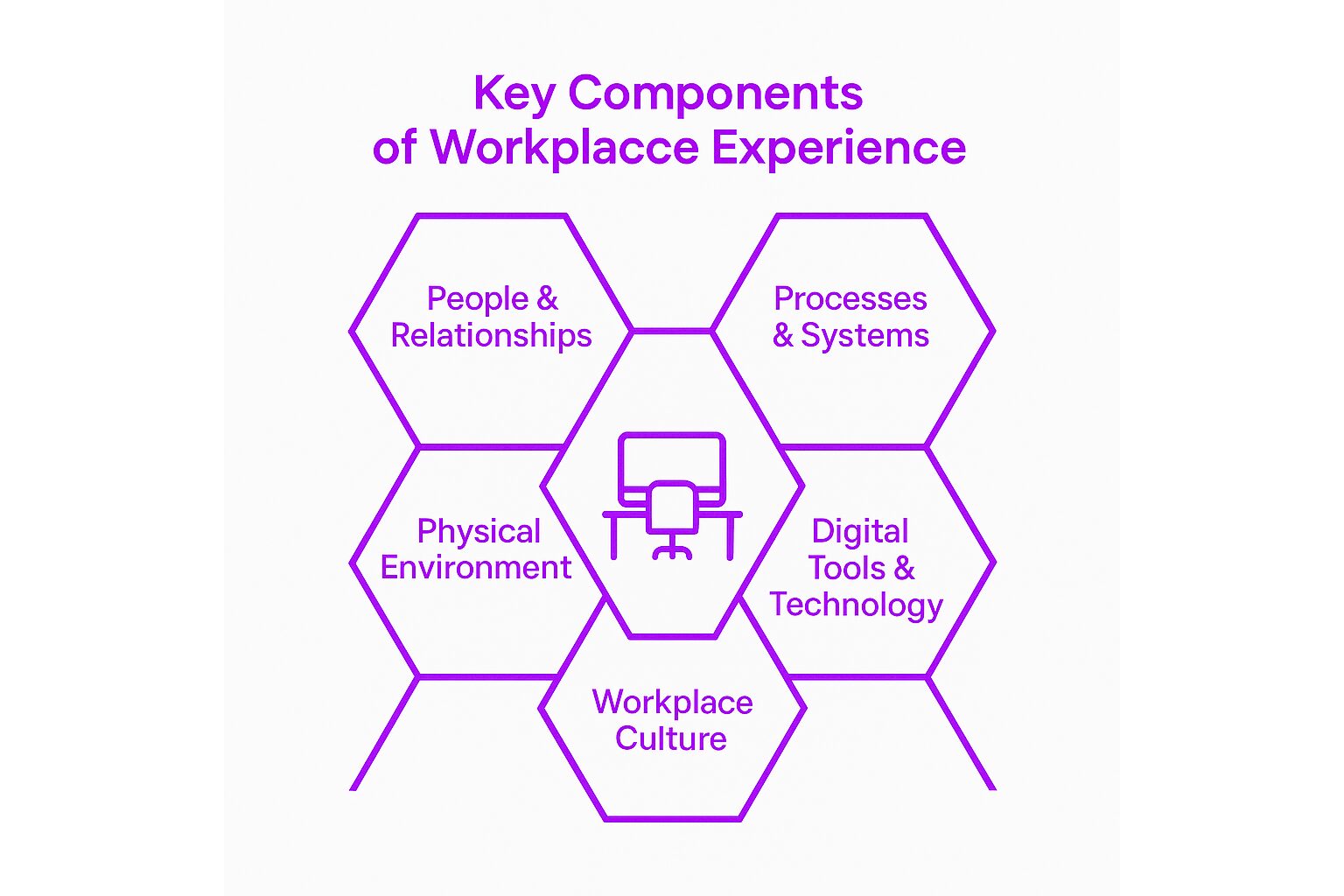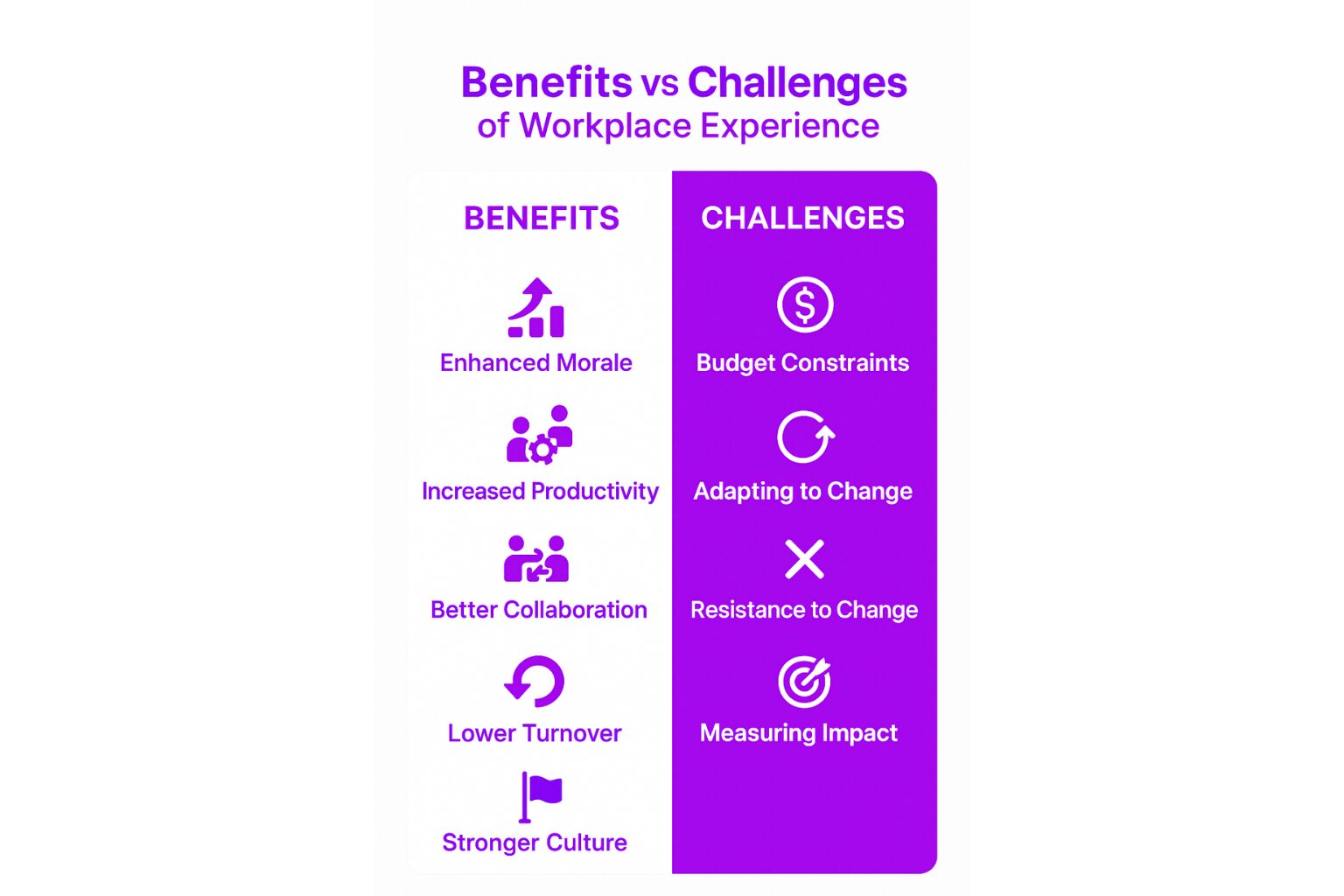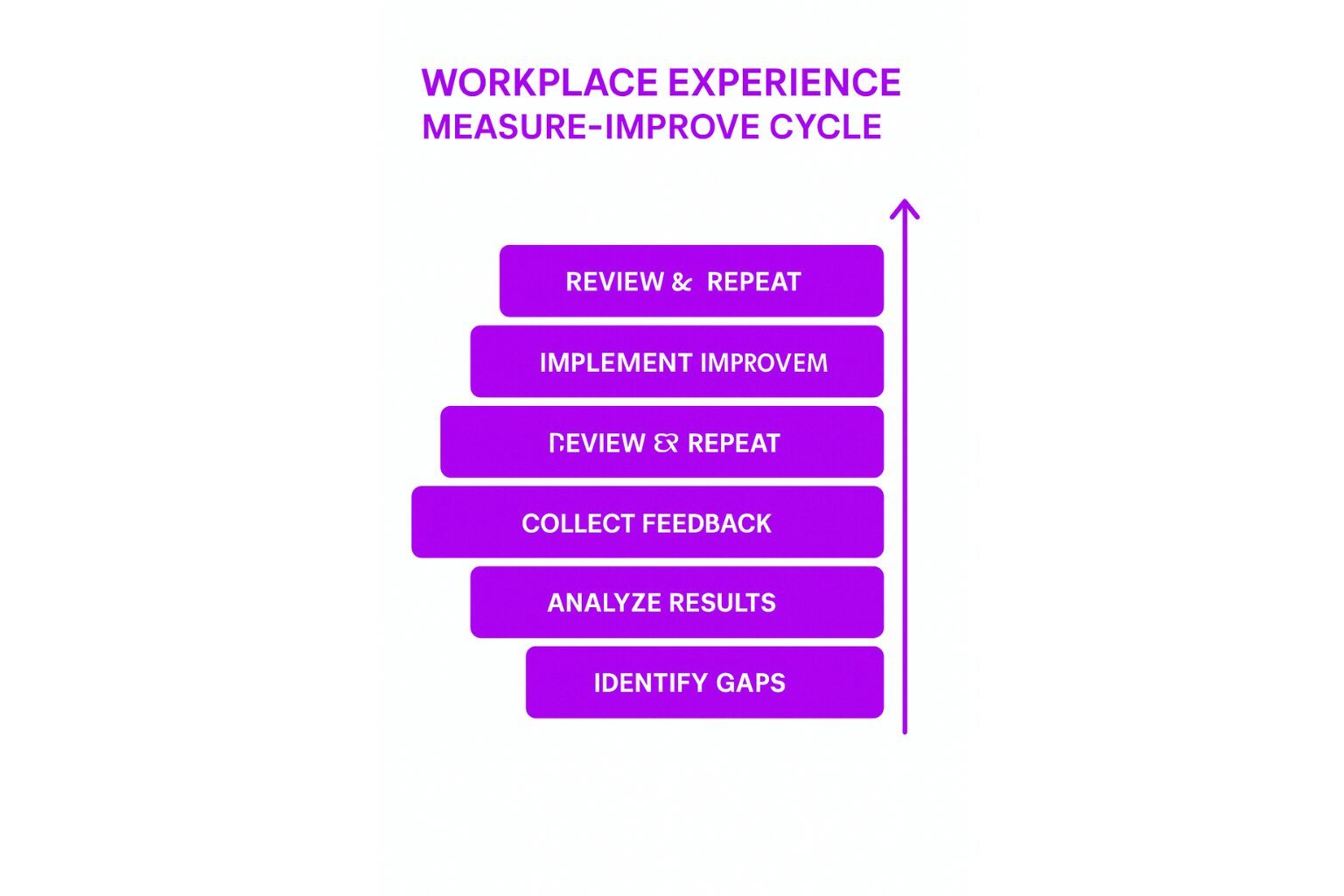Workplace Experience Definition
Workplace experience refers to the sum of all interactions and experiences employees have within their working environment, encompassing both the physical and digital spaces, as well as the organizational culture. It includes everything from the tools employees use, the way their work is structured, to the environment they work in and the relationships they build with colleagues and management. Workplace experience affects employee satisfaction, productivity, engagement, and retention.
As companies continue to adapt to evolving work environments, workplace experience has become an essential element of how businesses operate. A strong workplace experience focuses on creating a great workplace where employees feel supported, engaged, and empowered to perform at their best.
Comprehensive Explanation
The concept of workplace experience extends far beyond just the physical office space. It covers a wide array of factors that contribute to an employee’s daily work life, from their digital tools and resources to the culture and environment in which they operate. Workplace experience strategies are essential approaches for enhancing employee satisfaction and performance.
Key Components of Workplace Experience
-
People and Relationships
-
The quality of interactions between employees, managers, and leadership plays a significant role in shaping the overall workplace experience. Positive relationships foster trust, collaboration, and a sense of belonging, while poor relationships can lead to disengagement and frustration. Hiring a workplace experience manager can further enhance these relationships by fostering collaboration and implementing strategies that improve the overall employee experience.
-
Processes and Systems
-
The processes and systems in place, such as workflows, communication channels, and task management tools, contribute directly to the efficiency and effectiveness of employees. Well-organized processes ensure employees can complete tasks without unnecessary delays, while disorganized systems can lead to confusion and frustration.
-
Physical Environment
-
The design of the workspace, whether it’s a traditional office or a remote setup, is a critical component of the workplace experience. This includes everything from ergonomic furniture, lighting, and open spaces for collaboration to quiet zones for focused work. A comfortable environment enhances productivity and employee well-being.
-
Digital Tools and Technology
-
In the digital age, the tools and technologies employees use to complete their tasks are integral to their workplace experience. Effective tools should be user-friendly, integrated with other systems, and accessible remotely. Poor technology can hinder productivity and increase stress levels.
-
Workplace Culture
-
The culture of the organization, including its values, inclusivity, communication style, and leadership approach, profoundly impacts the workplace experience. A positive culture promotes engagement, loyalty, and a sense of purpose, while a toxic culture can lead to high turnover and dissatisfaction.
-
Workplace Flexibility
-
Flexibility in terms of remote work options, work hours, and autonomy in task execution are becoming more critical in the modern workplace. Offering flexibility not only improves employee work-life balance but also contributes to a more inclusive and adaptable environment.
Key Stages/Components of Workplace Experience
1. Physical Environment
The design and layout of the physical workplace play a crucial role in employee well-being and productivity. The design of the office space should cater to various needs:
-
Collaboration Areas: Open spaces for team meetings and brainstorming sessions. These areas should be comfortable, well-lit, and equipped with the necessary technology to facilitate group work.
-
Quiet Zones: Areas designated for deep work, where employees can focus without distractions. These spaces should be quiet, with ergonomic furniture and proper lighting to avoid fatigue.
-
Break** Spaces:** Relaxation zones that allow employees to unwind. These spaces contribute to reducing stress and improving morale.
The importance of the physical environment has become even more pronounced as many companies embrace hybrid and remote work. Employees working from home or other locations should have access to the same tools and support to maintain a healthy work environment.
2. Digital Tools and Workplace Technology
A seamless digital experience is integral to the workplace experience, especially in the context of remote work. Digital tools should enable:
-
Effective Communication: Platforms like Slack, Microsoft Teams, or Zoom help teams stay connected, collaborate on projects, and hold meetings efficiently.
-
Project Management and Collaboration: Tools like Trello, Asana, and Monday.com enable employees to track tasks, milestones, and project deadlines, ensuring transparency and accountability.
-
Knowledge Sharing: Platforms like Confluence or SharePoint help employees share information, access resources, and collaborate on documents and projects in real-time.
The integration of these tools creates a digital ecosystem that facilitates smooth workflows, supports collaboration, and ensures that employees can perform their tasks efficiently, regardless of their physical location. Additionally, these digital tools are crucial for supporting remote workers, ensuring their engagement and productivity.
3. Organizational Culture
Workplace culture is often described as the “personality” of the organization. It encompasses shared values, behaviors, and practices that influence how employees interact with each other and the work they do. A positive workplace culture fosters:
-
Trust and Respect: Open communication, mutual respect, and a collaborative spirit make employees feel valued and safe.
-
Inclusivity and Diversity: A workplace culture that embraces diversity and inclusion promotes equality and fosters innovation by drawing on diverse perspectives.
-
Transparency: Open and honest communication from leadership about company goals, challenges, and successes increases employee engagement and trust.
Creating a strong organizational culture involves leadership leading by example, establishing clear values, and encouraging feedback and collaboration from all employees.
4. Flexibility and Work-Life Balance
The rise of remote and hybrid work models has made workplace flexibility more important than ever. Flexibility is key to maintaining a healthy work-life balance, which directly impacts employee satisfaction and productivity. Key elements include:
-
Remote Work Options: Allowing employees to work from home or other locations provides them with greater control over their work environment and schedule.
-
Flexible Hours: Offering employees the freedom to set their working hours, rather than adhering to a rigid 9-to-5 schedule, helps them manage personal and professional responsibilities.
-
Autonomy in Task Management: Giving employees control over how they approach tasks and projects boosts morale and fosters a sense of ownership.
Organizations that embrace flexibility are more likely to attract top talent, increase employee engagement, and retain staff. Additionally, considering the needs of hybrid or remote workers in creating flexible work environments is crucial for accommodating those who are not consistently in the office.
Purpose and Importance of Workplace Experience
The purpose of workplace experience is to create an environment that maximizes employee satisfaction, productivity, and engagement. It’s a holistic approach that ensures employees have the support, resources, and environment they need to perform their best work. Workplace experience managers play a crucial role in overseeing and enhancing the workplace experience, particularly as organizations adapt to the competitive job market by creating dedicated positions focused on this function.
Why Workplace Experience Matters
-
Employee Engagement and Satisfaction
A positive workplace experience leads to higher levels of engagement. Employees who feel supported, connected, and valued are more likely to invest in their work and contribute meaningfully to the organization. -
Increased Productivity
A well-designed workplace, both physical and digital, allows employees to perform their tasks more efficiently. Clear processes, effective communication, and the right tools reduce barriers to productivity. -
Attraction and Retention of Talent
Companies with a strong workplace experience are more likely to attract top talent. Employees today are looking for more than just a paycheck—they want a fulfilling and supportive environment that aligns with their values and lifestyle. -
Improved Organizational Performance
Organizations that focus on the workplace experience see better overall performance. Higher engagement, retention, and satisfaction result in lower turnover, reduced absenteeism, and stronger business outcomes.
Benefits and Challenges of Workplace Experience and Employee Engagement
Benefits
-
Enhanced Employee Morale
When employees feel that their workplace environment supports their well-being and professional growth, their morale improves, leading to higher job satisfaction. -
Increased Productivity
Providing employees with the right tools, flexible working conditions, and a positive culture enhances their ability to focus and deliver results. -
Better Collaboration
A positive workplace experience fosters collaboration, where employees feel comfortable sharing ideas and working together toward common goals. -
Lower Turnover
Companies that invest in workplace experience see lower employee turnover, as workers are more likely to stay in an environment that supports their needs and values. -
Stronger Company Culture
When employees are satisfied with their experience, they become advocates for the company, contributing to a stronger, more unified company culture.
Challenges
-
Budget Constraints
Improving the workplace experience can require significant investment in tools, office design, and employee programs. Smaller organizations may face challenges in funding these initiatives. -
Adapting to Change
As workplace expectations evolve, businesses must continuously adapt. For example, balancing the needs of remote and in-office employees can be challenging. -
Resistance to Change
Employees accustomed to certain working styles may resist new changes, especially when it comes to workplace flexibility, new tools, or cultural shifts. -
Measuring Impact
The impact of workplace experience on business outcomes can be difficult to measure directly. Metrics like employee satisfaction, engagement, and turnover rates can provide insight, but correlating these directly to performance can be challenging.
Practical Tips and Best Practices for Enhancing Workplace Experience
-
Solicit Employee FeedbackRegularly engage employees through surveys, focus groups, and one-on-one conversations to understand their needs and preferences. Use this feedback to improve workplace processes, tools, and culture.
-
Create a Culture of RecognitionRecognize and reward employees for their hard work. Simple gestures like public acknowledgment, bonuses, or professional development opportunities go a long way in boosting morale.
-
Leverage Workplace Technology to Simplify WorkflowsInvest in modern communication tools, project management software, and knowledge-sharing platforms that streamline workflows and reduce friction in the employee experience. Workplace technology not only supports physical tasks but also fosters communication, collaboration, and social interaction, especially for remote workers.
-
Focus on Work-Life BalanceEncourage flexible work hours, offer remote work options, and ensure that employees have the support they need to maintain a healthy balance between their personal and professional lives.
-
Foster InclusivityCreate a workplace where everyone feels valued and included. Develop diversity and inclusion initiatives that support all employees, regardless of background or identity.
Measuring and Improving Workplace Experience
Measuring and improving workplace experience is crucial for organizations to understand the needs and preferences of their employees. A positive workplace experience can lead to increased employee engagement, productivity, and satisfaction, ultimately driving better business outcomes.
To measure workplace experience, organizations can use various metrics such as employee satisfaction surveys, feedback mechanisms, and key performance indicators (KPIs) aligned with organizational goals. Regularly assessing factors like employee satisfaction, engagement, and well-being can help identify areas for improvement.
Internal Communication and Workplace Experience
Internal communication plays a vital role in creating a positive workplace experience. Effective communication channels within the organization are crucial for ensuring that employees feel connected and informed.
Increasing Employee Engagement
Increasing employee engagement is essential for a positive workplace experience. Employee engagement refers to the level of commitment, motivation, and satisfaction employees feel in their roles. A highly engaged workforce is more productive, innovative, and loyal.
Related Sub-concepts
Employee Experience (EX)
Employee experience is a broader term that encompasses all aspects of an employee’s journey with the company, from recruitment to exit. Workplace experience is a subset of employee experience, focusing specifically on the environment in which employees work.
Digital Employee Experience (DEX)
Digital employee experience focuses on the digital tools and platforms employees use in their day-to-day work. A seamless digital experience enhances productivity and engagement by providing intuitive, easy-to-use technology.
Workplace Culture
Workplace culture refers to the shared values, beliefs, and practices within an organization. While it’s a core part of workplace experience, it is distinct in that it shapes how employees behave, interact, and collaborate.
Real-World Examples and Use Cases
Simpplr’s Approach to Workplace Experience
Simpplr’s platform is designed to enhance the workplace experience by centralizing communication, fostering employee engagement, and simplifying knowledge-sharing. Its employee-focused tools improve communication flow, increase transparency, and help organizations align their culture with business goals.
Google’s Work Environment
Google is known for its exceptional workplace experience, offering employees flexible work options, creative workspaces, and numerous amenities designed to support well-being. This approach has helped Google maintain high employee satisfaction and attract top talent.
Salesforce’s Workplace Culture
Salesforce is another example of a company with a strong workplace experience. Through its commitment to employee development, transparent communication, and community-building initiatives, Salesforce has created an environment where employees thrive.







